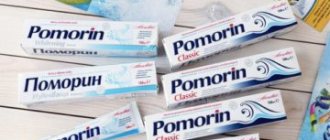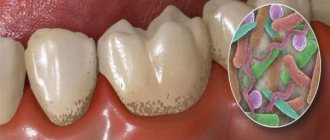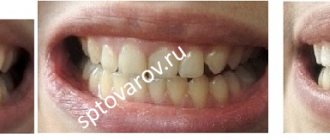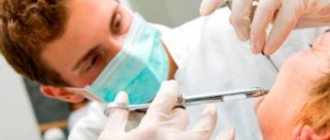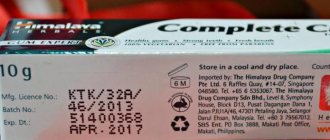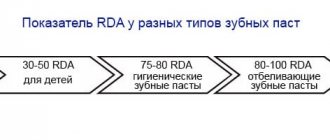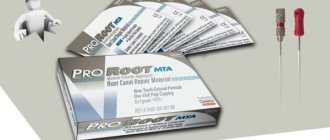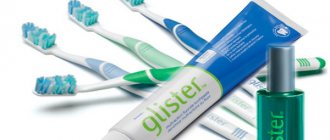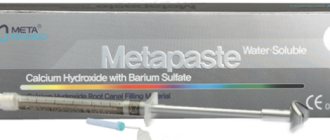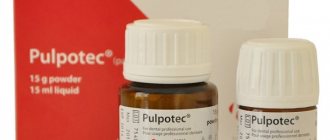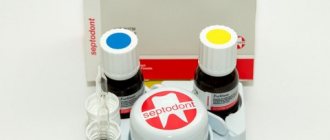1934
Pulposeptin is a dental paste for the treatment of bacterial root canal infections.
The drug is produced on the basis of antibiotics with bacteriostatic and bactericidal action, it stops the growth and reproduction of pathogenic microflora, and destroys some species. The paste is used in pediatric and adult dentistry.
Composition and properties of the product
The main active ingredients in the drug:
- Chloramphenicol is a broad-spectrum antibiotic, active against staphylococci, streptococci, Neisseria, Klebsiella, as well as those flora that are resistant to penicillin, sulfonamides, streptomycin.
- Neomycin sulfate - used exclusively topically (due to its high toxic effect on the kidneys and liver), has a bactericidal effect on cocci, protozoa, and bacilli.
- Dexamethasone is a synthetic steroid hormone that has an anti-inflammatory effect. Relieves swelling, allergic manifestations, reduces the level of intoxication.
- Polyethylene glycol is an excipient, solvent, emollient component in ointments and pastes.
- 2-phenoxyethanol is a preservative.
A balanced formula of antibiotics with a wide range of antimicrobial action quickly and effectively suppresses infection in the pulp (the loose structure that fills the tooth cavity).
The active substances do not enter the systemic bloodstream, do not have a negative effect on the functioning of internal organs, and are not addictive.
The hormone included in the composition blocks the progression of the acute inflammatory process in the periapical tissues - the soft structures surrounding the apex of the tooth root, the alveolar bone.
How does chronic fibrous pulpitis manifest itself and methods of its treatment.
Come here to learn more about the symptoms of diffuse pulpitis.
At this address https://www.vash-dentist.ru/lechenie/zubyi/pulpit/pri-gipertroficheskom.html we will talk about the differences between hypertrophic pulpitis and other types of pathology.
Pharmacological properties
Pulposeptin is actively used in dentistry to treat severe inflammation; it is effective due to the fact that it has the following effects on the body:
- bacteriostatic;
- anti-inflammatory;
- does not affect the protective functions of the body;
- safe for use on periapical tissues.
The drug contains two antibiotics, which were specially selected to create balanced protection.
Both of them are characterized by extensive bacteriostatic action. Thanks to their use, an infection that has developed in the pulp can be quickly eliminated. The purpose of both antibiotics is local use, which indicates their complete safety for the body in the form of addiction.
Chloramphenicol was chosen as the active ingredient due to its powerful antimicrobial properties. Its active action is directed against most gram-negative and gram-positive bacteria. It suppresses bacterial strains and is capable of destroying pathogenic microflora that are resistant to the penicillin group, streptomycin, and sulfonamides.
Neomycin sulfate has a destructive effect on bacteria with persistent resistance to chloramphenicol. Its active action is directed against gram-negative microbes, cocci.
The dosage of dexamethasone in the drug was increased, due to which inflammatory processes are quickly blocked, while relieving acute symptoms. The main thing is that the properties of this substance do not have a detrimental effect on the body’s ability to react defensively.
Indications
Pulposeptin is used in endodontics to eliminate the source of infection. Medicinal dressing of root canals (paste injection) is done for the following pathological conditions:
- Periapical periodontitis is an infectious or traumatic inflammation of the periodontium with a violation of the integrity of the ligaments (secure the tooth in the alveolus), internal and external alveolar processes (cortical plate).
- Periapical abscess is a local limited accumulation of pus on the surface of the alveolar process (externally or internally). It develops against the background of advanced caries, periodontal diseases, and chipped teeth.
- Periapical granuloma is a clearly limited inflammation of an infectious nature, proliferation of soft tissues with the formation of nodules (granulomas).
- Gangrenous pulpitis is purulent inflammation of the neurovascular bundle of the tooth, followed by tissue death.
- A fistula is a canal from the root of a tooth through the jawbone, which is formed during the disintegration of an inflammatory focus for the release of pus. After the inflammation has stopped, the wound heals and heals.
- Odontogenic radicular cysts – arising in a chronic inflammatory focus of periodontal tissues. The neoplasm is located at the apex of the tooth root. An inflammatory infiltrate and hemorrhages are found in the cavity.
Pulposeptin paste is also used for prophylactic purposes to prevent the proliferation of pathogenic flora after endodontic manipulations (removal of canal contents, preparation for the filling stage).
Instructions for use
Before applying the paste, the root canal is thoroughly prepared. For endodontic treatment, EDTA (acid) is used to expand the canal and improve the permeability of Puloseptin into the walls.
The treatment is carried out several times alternately with sodium hypochlorite (disinfector, antiseptic irrigation solution). After completing the preparatory procedure, the dental canal is dried.
The paste is injected to the apex (the very apex of the root) using a canal filler - an endodontic instrument in the form of a conical spiral, a helical rod with a tail for rotation. The resource of one filler is 3 cycles of filling one channel.
After filling with paste, the canal is closed with a sealed bandage (temporary filling) made of indifferent material (which does not affect the surrounding tissue). This allows you to quickly restore the anatomical shape of the crown. The temporary filling can be easily removed.
The required dose of Pulposeptin paste is determined individually. The maximum amount for filling a root canal in an adult patient is 20 mg.
The duration of the treatment course is 5-7 days. This time is enough to destroy the infection, relieve swelling, reduce inflammation, and stop an allergic reaction.
On a second visit, the dentist removes the filling material and any remaining drug. Cleans and carries out antiseptic treatment of the canal, thoroughly dries the cavity.
Then the root is filled with filling material (two-component paste based on epoxy resins, radiopaque material based on zinc oxide and eugenol).
Attention! Pulposeptin paste is intended exclusively for professional use in dental offices. Self-treatment of purulent inflammation of the oral cavity at home is unacceptable.
Signs of chronic gangrenous pulpitis and treatment of pathology.
In this article you will find instructions for using Pulpotec in pediatric practice.
Here https://www.vash-dentist.ru/lechenie/zubyi/pulpit/slozhnosti-vyiyavleniya-nachalnogo.html all the most important things about initial reversible pulpitis.
Mode of application
Before applying the paste, prepare the root canal, which consists of endodontic treatment of the canal up to the apex using EDTA-containing materials (liquid for chemical expansion of canals, gel for expansion of canals) with alternating treatment with sodium hypochlorite. After completion of treatment, dry the canal and introduce Pulposeptin paste using a canal filler to the apex. Cover with a temporary bandage. The dosage is determined separately in each specific case.
A full dose can be considered 20 mg of paste per channel. The drug does not have undesirable systemic effects.
When you return after 5-7 days, remove the temporary covering material and the remaining Pulposeptin paste, clean and treat the root canal using all appropriate materials and techniques. After completion of treatment, thoroughly dry the canal and fill it with appropriate root canal filling material.
For professional use in healthcare facilities only. Do not use at home.
Warnings
Subject to storage conditions and proper transportation, the drug does not cause side effects.
In rare cases, symptoms of a local allergic reaction can be observed in people with high sensitivity to antibiotics:
- burning, irritation of the gums in the area of the diseased tooth;
- pathological swelling of the oral mucosa and tongue;
- local increase in temperature, hyperemia of soft tissues;
- rashes, both on the mucous membrane and on the outside of the skin in the area of the nasolabial triangle.
There are no contraindications to the use of the drug; no incompatibility with other drugs has been identified.
Pulposeptin does not penetrate the hematogenous (blood) and placental barrier. Does not have a teratogenic effect on the fetus (does not disrupt embryonic development through toxic effects). Therefore, the paste can be used in the treatment of pregnant women in any trimester.
The drug does not pass into breast milk and does not affect the physical and mental development of the baby. Pulposetin is harmless for nursing mothers.
Release form, price, analogues
The drug for topical use is available in the form of a paste of dense consistency in aluminum tubes with a volume of 10 g. The medicine can be stored in the refrigerator at a temperature of at least 4°C or at room temperature up to 20°C.
Important! At higher temperatures, the paste separates, making it unsuitable for use for medicinal purposes.
Before use, to ensure the plasticity of the material, the preparation can be slightly warmed up. It is enough to hold the tube in your clenched palm for no more than half a minute.
The cost of Pulposeptin in online pharmacies varies from 940 to 1146 rubles. for one unit of goods. Manufacturer – Russia.
Antiseptic analogues for filling root canals (therapy of pulpitis, periodontitis):
- Yodent (iodoform paste) - available in a 25 g darkened glass bottle. Manufacturer - Russia.
Cost – 162 rubles. Non-hardening paste is used for acute and chronic periodontitis. The main active ingredient is chlorophenol, iodoform. A side effect is pain during the first 1-2 days after filling the canal with paste. - Abscess Remedy - creson-based paste (disinfector) with dexamethasone. Available in plastic or glass jars. Manufacturer – Switzerland. Price – 2150 rub. Indicated for pulpitis, purulent periodontitis, abscesses.
- Tempofor is a paste based on creosote, thymol, camphor, and iodoform. Manufacturer – France. Cost – 1980 rubles. Indications: treatment of pulpitis, periodontitis, baby teeth in children, including those with absorbable roots.
- Septomixin is a broad-spectrum antiseptic paste with dexamethasone.
Active ingredients: neomycin sulfate, polymyxin sulfate, tyrothricin. Available in 7.5 g tubes. Manufacturer: France. Price – 4988 rub. It is used to treat severe forms of periodontitis that occur with complications. - Ledermix is a paste based on demeclocycline and triamcinolone (synthetic hormone). Produced in aluminum tubes of 5 g. Manufacturer – Germany. Cost −4500 rub. Indications: treatment of gangrene, acute periodontitis, pulpitis.
- Grinazol is a drug based on metronidazole for the treatment of gangrenous pulpitis. Tube volume – 4.5 g. Manufacturer – France. Price – 4230 rub.
Indications for use and purposes of use
As mentioned above, the paste is used for inflammatory processes, periodontitis, gangrenous pulpitis, tooth and gum cysts.
The drug is placed into the inflamed cavity for the following purposes:
- to eliminate severe pain;
- to destroy pathogenic microflora of the root canal and dentinal tissue;
- to reduce the inflammatory process of periodontium;
- to stimulate regenerative processes in bone tissue.
What you need to know about pulpitis, its symptoms and treatment:
Reviews
If you have had root canals treated with Pulposeptin, please share your experience using this remedy. Tell us if you had any complications, how quickly the infection and symptoms such as toothache, inflammation, swelling resolved, and how quickly you returned to your normal eating regimen.
If you find an error, please select a piece of text and press Ctrl+Enter.
Tags pulpitis
Did you like the article? stay tuned
Previous article
Purpose of the Coffin spring in orthodontic appliances
Next article
Impression of teeth during treatment with braces, why can’t you do without it?
